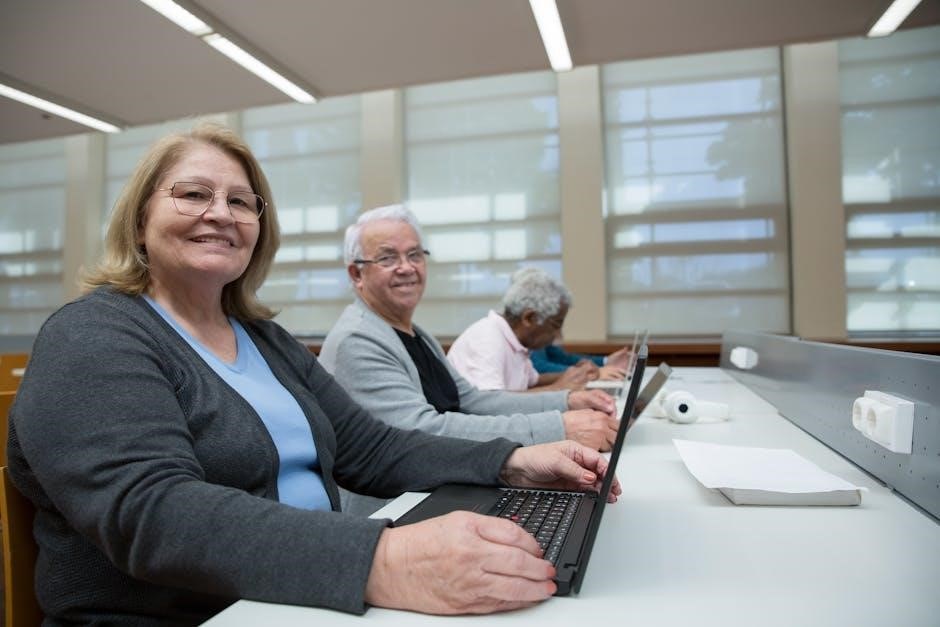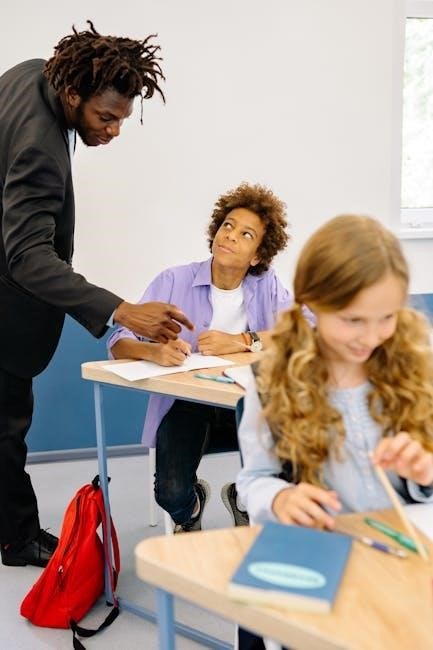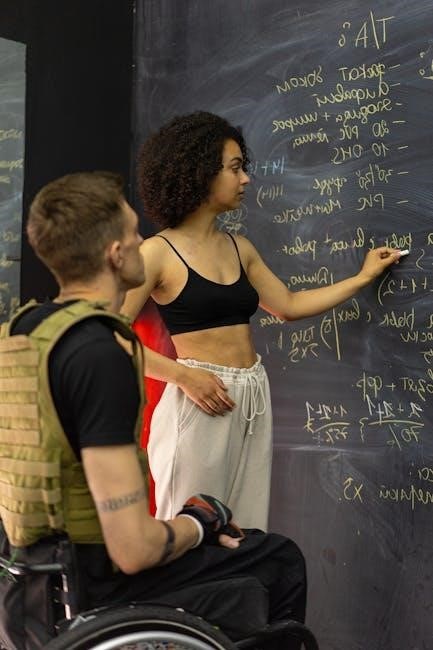Inclusive classroom strategies are essential for supporting diverse learners․ Techniques like multisensory instruction and AI tools create engaging‚ personalized learning experiences‚ fostering academic success and social growth․
Understanding the Importance of Inclusive Education
Inclusive education is fundamental for creating equitable learning environments where all students thrive․ It addresses the diverse needs of learners‚ ensuring access to quality education regardless of abilities‚ backgrounds‚ or challenges․ By fostering inclusivity‚ educators promote social growth‚ collaboration‚ and mutual respect among students․ Inclusive practices also support struggling learners by providing tailored strategies‚ such as multisensory instruction and AI-driven tools‚ to address individual needs․ Early identification of learning disabilities and personalized interventions are critical for helping students overcome barriers․ Inclusive education empowers teachers to create supportive classrooms‚ enabling all students to reach their full potential and preparing them for a diverse‚ interconnected world․
Overview of Challenges Faced by Struggling Learners
Struggling learners often face significant challenges in achieving academic success․ These challenges may stem from learning disabilities‚ attention deficits‚ or processing difficulties‚ which can hinder their ability to engage with curriculum materials․ Additionally‚ social-emotional barriers‚ such as low confidence or anxiety‚ can further complicate their learning journey․ Traditional teaching methods may not adequately address these diverse needs‚ leading to gaps in understanding and motivation․ Early identification of these challenges is crucial to providing timely support․ Without tailored interventions‚ struggling learners may fall behind peers‚ experiencing frustration and disengagement․ Understanding these challenges is the first step toward creating inclusive classrooms that cater to all learners’ needs‚ ensuring equitable opportunities for success․

Assessment and Identification of Learning Needs
Effective assessment tools help identify learning disabilities early‚ enabling personalized support․ AI-driven evaluations and individualized plans ensure tailored strategies to address diverse needs‚ fostering inclusive growth․
Early Identification of Learning Disabilities
Early identification of learning disabilities is crucial for providing timely support․ Teachers can use universal screening tools to detect signs of challenges in reading‚ writing‚ or math; Progress monitoring and diagnostic assessments help pinpoint specific difficulties‚ enabling interventions before gaps widen․ Collaborating with parents and specialists ensures comprehensive understanding․ Technology‚ such as AI-based assessments‚ streamlines the process‚ offering data-driven insights․ Early action fosters inclusive environments‚ allowing tailored strategies to be implemented․ This proactive approach empowers students to overcome barriers‚ promoting long-term academic and personal growth․ By addressing needs early‚ educators create a foundation for success‚ ensuring all learners thrive in diverse classroom settings․
Using AI Tools for Personalized Learning Assessments
AI tools are revolutionizing personalized learning assessments by providing tailored insights into student needs․ These tools use data to identify strengths and weaknesses‚ enabling targeted interventions․ Adaptive assessments adjust difficulty based on student responses‚ ensuring accurate skill measurement․ AI-driven platforms generate detailed reports‚ helping teachers craft individualized plans․ Additionally‚ AI tools like ChatGPT can create interactive exercises and simulations‚ engaging students in dynamic ways․ Voice-to-text options and real-time feedback further enhance accessibility and understanding․ By leveraging AI‚ educators can efficiently monitor progress and deliver support‚ fostering inclusive learning environments․ This technology not only streamlines assessment processes but also empowers teachers to address diverse learning needs effectively‚ ensuring no student is left behind in their educational journey․
Developing Individualized Education Plans (IEPs)
Developing Individualized Education Plans (IEPs) is a collaborative process aimed at addressing the unique needs of students with disabilities․ These plans outline specific learning objectives‚ accommodations‚ and services tailored to each student’s requirements․ Key components include measurable goals‚ assessment methods‚ and timelines for progress monitoring․ Teachers‚ parents‚ and specialists work together to ensure the plan is comprehensive and aligned with the student’s strengths and challenges․ Regular reviews and updates are essential to reflect changing needs and celebrate achievements․ By focusing on personalized goals and supports‚ IEPs empower students to access the curriculum and thrive academically․ This structured approach ensures accountability and equips educators with strategies to meet diverse learning needs effectively․

Teaching Strategies for Struggling Learners
Effective strategies include multisensory instruction‚ AI tools for personalized learning‚ and guided individual practice․ These approaches help address diverse needs‚ ensuring tailored support and skill development․
Multisensory Instruction for Diverse Learners
Multisensory instruction engages students through visual‚ auditory‚ and kinesthetic approaches‚ catering to diverse learning styles․ This method is particularly effective for struggling learners‚ as it allows them to process information in ways that suit their individual needs․ By incorporating multiple senses‚ teachers can enhance retention and understanding․ For example‚ using manipulatives for math concepts or combining speech-to-text tools with written exercises can make learning more accessible․ This approach also fosters engagement and confidence‚ especially for students with learning disabilities or ADHD․ Multisensory instruction creates a dynamic and inclusive learning environment‚ ensuring that all students have opportunities to succeed․
Using Visual‚ Auditory‚ and Kinesthetic Approaches
Combining visual‚ auditory‚ and kinesthetic approaches ensures that all learners can access information in ways that align with their strengths․ Visual learners benefit from diagrams‚ images‚ and videos‚ while auditory learners thrive with discussions‚ audio recordings‚ and verbal instructions․ For kinesthetic learners‚ hands-on activities‚ manipulatives‚ and role-playing are ideal․ By integrating these methods‚ teachers create a comprehensive learning experience that caters to diverse needs․ For example‚ using multimedia presentations or interactive simulations can engage multiple senses simultaneously․ This multi-faceted approach not only enhances understanding but also boosts engagement and confidence‚ particularly for struggling learners who may find traditional methods challenging․
Guided Individual Practice for Intensive Skill Development
Guided individual practice is a powerful strategy for intensive skill development‚ particularly for struggling learners․ This approach involves one-on-one or small group instruction‚ allowing teachers to provide personalized attention and feedback․ By breaking skills into manageable steps‚ educators can help students build confidence and mastery․ For instance‚ students with learning disabilities or ADHD benefit from structured‚ repetitive practice tailored to their pace․ Teachers can incorporate multisensory techniques during these sessions to reinforce learning․ Regular progress monitoring ensures that instruction is adjusted to meet individual needs․ This method not only accelerates skill acquisition but also fosters a sense of accomplishment‚ making it a cornerstone of inclusive education․

Differentiated Instruction Techniques
Differentiated instruction tailors teaching to meet diverse learner needs․ Using AI tools to create personalized materials and shifting focus from tasks to learning enhances engagement and understanding․
Creating Learning Materials with AI Tools
AI tools enable teachers to generate personalized learning materials tailored to students’ needs․ By leveraging generative AI‚ educators can adapt content to suit individual learning styles‚ ensuring accessibility and engagement․ These tools also support the creation of interactive simulations‚ multimedia presentations‚ and adaptive assessments‚ fostering deeper understanding and retention․ Additionally‚ AI can assist in translating materials into multiple languages‚ catering to diverse linguistic backgrounds․ This approach not only enhances inclusivity but also allows teachers to focus on instructional strategies‚ promoting a more dynamic and effective learning environment for all students․
By integrating AI-generated materials‚ educators can address various learning challenges‚ ensuring that every student has the resources they need to succeed․ This innovative approach supplements traditional teaching methods‚ making lesson planning more efficient while maintaining high educational standards․
Switching Emphasis from Task Completion to Learning
Switching the focus from task completion to learning emphasizes understanding and mastery over finishing assignments․ This approach helps struggling learners by allowing them to engage deeply with content at their own pace․ By prioritizing comprehension‚ teachers can identify and address individual learning gaps‚ ensuring students grasp foundational concepts before moving forward․ This strategy also reduces anxiety related to finishing tasks quickly‚ fostering a more inclusive and supportive classroom environment․ Additionally‚ it encourages active participation and critical thinking‚ enabling students to develop a growth mindset and take ownership of their learning process․ This shift ensures that all learners‚ regardless of their abilities‚ have the opportunity to succeed and grow academically․
Implementing Routine Use of Scaffolding Techniques
Scaffolding techniques provide temporary support to help struggling learners master new skills and concepts․ By breaking tasks into smaller‚ manageable steps‚ teachers can guide students through complex material‚ ensuring understanding at each stage․ Visual aids‚ models‚ and guided practice are effective scaffolding tools that make learning accessible․ As students gain confidence and competence‚ the support is gradually reduced‚ fostering independence․ This approach not only builds academic skills but also enhances problem-solving abilities and critical thinking․ Regular use of scaffolding creates a supportive learning environment‚ enabling students to overcome challenges and achieve their full potential․ It is particularly beneficial for diverse learners‚ helping them connect new information to prior knowledge and experiences․

Technology Integration in the Classroom
Technology integration enhances learning through effective search tools‚ AI-driven assessments‚ and voice-to-text options‚ creating an inclusive environment for all students to thrive․
Teaching Students to Use Search Tools Effectively
Teaching students to use search tools effectively is crucial for their academic success․ Start by showing them how to locate the search box on websites and use shortcuts like Control F (or Command F on Mac) to quickly find specific information․ Encourage brainstorming search terms and using truncation (*) and wildcard (?) symbols to broaden search results․ Demonstrate how to refine queries for relevance and accuracy․ Modeling these strategies helps students develop essential research skills․ Additionally‚ guide students in identifying credible sources and avoiding irrelevant information․ By fostering these skills‚ educators empower learners to navigate digital resources confidently‚ supporting their independence and critical thinking abilities in an inclusive classroom environment․
Utilizing Truncation and Wildcard Symbols in Research
Truncation () and wildcard (?) symbols are powerful tools for refining research․ Truncation broadens searches by shortening words (e․g․‚ “learn” for “learner” or “learning”)․ Wildcards replace characters (e․g․‚ “lear?” for “learn” or “learm”)․ These techniques help students find more relevant results without missing key information․ Teaching these strategies enables learners to refine their searches‚ improving search accuracy and efficiency․ For struggling students‚ mastering these skills can reduce frustration and enhance research outcomes․ By incorporating these methods‚ educators empower students to navigate complex searches confidently‚ ensuring they access the most relevant resources for their academic tasks․
Exploring Voice-to-Text Options for Inclusive Learning
Voice-to-text tools are invaluable for inclusive learning‚ enabling students to convert spoken words into written text․ These tools are particularly beneficial for learners with writing difficulties‚ dyslexia‚ or visual impairments․ By allowing students to express their thoughts verbally‚ voice-to-text software promotes equity and accessibility․ Educators can integrate platforms like Dragon NaturallySpeaking or Apple Dictation to support diverse learners․ These technologies not only enhance writing experiences but also build confidence and engagement․ Voice-to-text options cater to individual needs‚ ensuring all students can participate fully in academic tasks․ This approach fosters an inclusive environment where every learner can thrive‚ regardless of their abilities or challenges․

Active Learning and Engagement Strategies

Active learning fosters engagement through inquiry-based methods‚ role-playing‚ and debates․ These strategies encourage critical thinking and participation‚ helping students apply knowledge in meaningful ways․
Inquiry-Based Methods for Active Participation
Inquiry-based methods encourage students to explore topics through open-ended questions and collaborative activities․ This approach fosters critical thinking and active engagement‚ allowing learners to take ownership of their education․ By presenting real-world scenarios‚ teachers can help students connect theoretical concepts to practical applications․ These methods are particularly effective for struggling learners‚ as they provide opportunities for hands-on exploration and personalized learning․ Teachers can guide students in formulating questions‚ gathering information‚ and synthesizing knowledge‚ which builds confidence and problem-solving skills․ Incorporating case studies‚ debates‚ and role-playing activities further enhances this process‚ creating a dynamic and inclusive learning environment that caters to diverse needs and abilities․
Case-Study Approaches and Role-Playing Activities
Case-study approaches and role-playing activities are powerful tools for engaging students in real-world scenarios‚ making abstract concepts tangible․ These methods allow learners to explore complex situations collaboratively‚ fostering teamwork and problem-solving skills․ Role-playing activities‚ in particular‚ enable students to step into different perspectives‚ enhancing empathy and understanding․ For struggling learners‚ these approaches provide a supportive environment to practice communication and decision-making․ Teachers can use case studies to present authentic challenges‚ encouraging students to analyze and propose solutions․ This interactive learning strategy not only boosts critical thinking but also accommodates diverse learning styles‚ ensuring all students can participate meaningfully․ By simulating real-life experiences‚ educators help students build confidence and practical skills․
Debates and Simulations to Promote Critical Thinking
Debates and simulations are dynamic strategies that encourage active participation and critical thinking․ These activities immerse students in real-world scenarios‚ allowing them to explore complex issues from multiple perspectives․ Debates‚ for instance‚ require students to research‚ analyze‚ and articulate arguments‚ fostering skills in communication and logical reasoning․ Simulations‚ on the other hand‚ enable learners to experience hypothetical situations‚ such as historical events or scientific phenomena‚ in a controlled environment․ Both methods engage struggling learners by making abstract concepts relatable and interactive․ By encouraging collaboration and healthy competition‚ debates and simulations help students develop confidence‚ problem-solving abilities‚ and a deeper understanding of the subject matter․ These approaches are particularly effective in inclusive classrooms‚ as they cater to diverse learning styles and promote equity in participation․

Behavior Management and Support Systems
Effective behavior management involves creating a positive classroom environment‚ setting clear expectations‚ and using strategies like positive reinforcement to support all learners‚ fostering a culture of respect and inclusivity․
Strategies for Managing Challenging Behaviors
Managing challenging behaviors requires a combination of proactive and responsive strategies․ Teachers can use positive reinforcement to encourage positive behavior‚ while also identifying triggers to prevent escalations․ Clear expectations and consistent consequences help establish a structured environment․ Providing students with choices empowers them and reduces defiance․ Additionally‚ techniques like paraphrasing and reflection can help students process emotions and de-escalate conflicts․ Collaborative problem-solving with students fosters ownership of their behavior and encourages accountability․ By integrating these strategies‚ educators can create a supportive classroom culture that addresses behavioral challenges effectively while promoting social-emotional growth․
Creating a Positive Classroom Environment
Fostering a positive classroom environment is crucial for student success․ Establishing a culture of respect‚ empathy‚ and inclusivity encourages social-emotional growth․ Teachers can implement restorative practices‚ such as class meetings‚ to build community and resolve conflicts․ Incorporating student voice through choice boards and reflective activities enhances engagement․ Using visual supports‚ like emotional regulation charts‚ helps students manage feelings․ Celebrating diverse backgrounds and experiences promotes equity and belonging․ By modeling positive interactions and providing a safe space for expression‚ educators create an environment where all learners thrive academically and socially․
Modeling Troubleshooting Techniques for Students
Modeling troubleshooting techniques empowers students to approach challenges confidently․ Teachers can demonstrate problem-solving by verbalizing their thought process aloud‚ showing how to identify and address issues systematically․ For instance‚ when conducting research‚ instructors can model how to refine search terms or use tools like truncation and wildcards to broaden results․ Encouraging students to reflect on their own problem-solving strategies fosters independence․ By breaking down complex tasks into manageable steps and providing guided practice‚ educators help learners develop resilience․ Celebrating effort rather than just success reinforces a growth mindset․ These practices not only enhance academic skills but also prepare students for real-world challenges‚ making them adept at navigating obstacles independently․

Collaboration and Communication
Encouraging peer support and collaboration fosters a positive learning environment․ Brainstorming search terms and sharing common queries help students work together effectively‚ enhancing research skills and teamwork․
Brainstorming Search Terms for Effective Research
Brainstorming search terms is a powerful strategy to enhance research skills‚ especially for struggling learners․ By guiding students to convert questions into specific keywords‚ teachers help them focus their searches․ This method encourages critical thinking and clarifies research objectives․ Students learn to refine their queries using truncation symbols (*) and wildcard symbols (?) to broaden or narrow results․ Collaborative brainstorming sessions also foster teamwork and shared understanding․ Posting common search queries as references provides students with a starting point‚ reducing frustration and boosting confidence․ This approach not only improves research efficiency but also empowers learners to navigate complex topics independently‚ making it a valuable tool in inclusive classrooms․
Posting Common Search Queries for Student Reference
Posting common search queries in the classroom serves as a valuable resource for students‚ especially those who struggle with research․ By displaying frequently used search terms and strategies‚ teachers provide a clear framework for effective searching․ This approach reduces confusion and saves time‚ allowing students to focus on understanding content rather than figuring out how to find it․ Teachers can also include examples of truncation (*) and wildcard (?) techniques‚ demonstrating how these tools can broaden or narrow search results․ Making these resources easily accessible helps students develop independence and confidence in their research skills‚ creating a more inclusive and supportive learning environment․

Encouraging Peer Support and Collaboration
Encouraging peer support and collaboration fosters a positive and inclusive classroom environment․ By pairing students for group projects or one-on-one assistance‚ teachers can help struggling learners build confidence and skills․ Peer support allows students to share ideas‚ discuss challenges‚ and learn from one another‚ promoting active participation․ Teachers can facilitate this by modeling collaborative behaviors and providing structured opportunities for interaction․ Additionally‚ incorporating AI tools to create tailored learning materials ensures that all students‚ including those with disabilities‚ can engage meaningfully․ This approach not only strengthens academic performance but also nurtures social-emotional growth‚ creating a sense of belonging and mutual respect among students․
Summarizing Key Strategies for Struggling Learners
Effective strategies for supporting struggling learners include multisensory instruction‚ which engages multiple senses to enhance understanding‚ and guided individual practice for intensive skill development․ Utilizing AI tools for personalized learning assessments and creating tailored resources ensures each student’s needs are met․ Additionally‚ scaffolding techniques provide temporary support‚ helping students build confidence and independence․ Encouraging active participation through inquiry-based methods‚ debates‚ and simulations fosters critical thinking and engagement․ Teaching search strategies‚ such as brainstorming terms and using truncation symbols‚ equips students with essential research skills․ By combining these approaches‚ educators create an inclusive environment that promotes academic success and social growth for all learners․
Importance of Continuous Professional Development
Continuous professional development is crucial for educators to stay updated on inclusive education practices․ It enables teachers to learn about new tools‚ such as AI-driven resources and multisensory instruction‚ ensuring they can adapt to diverse student needs․ By engaging in ongoing training‚ educators can refine their use of scaffolding techniques and differentiated instruction‚ fostering a more supportive learning environment․ Professional development also encourages collaboration among teachers‚ allowing them to share best practices and innovative strategies․ Ultimately‚ it enhances their ability to address the unique challenges faced by struggling learners‚ leading to improved student outcomes and a more equitable educational experience in today’s dynamic classroom settings․